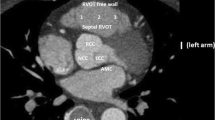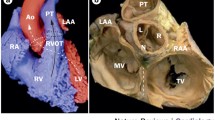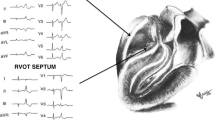Abstract
Left ventricular outflow tract (LVOT) tachycardia is an uncommon form of idiopathic ventricular tachycardia (IVT). The underlying mechanism of this arrhythmia appears to be cyclic AMP-medicated triggered activity. The tachycardia occurs in the absence of structural heart disease and is generally benign, presenting commonly as palpitations and presyncope. It can manifest either a right or left bundle branch block morphology with an inferior axis. Subtle variations in the QRS morphology in leads I, V1, and V2 can help in localizing the anatomic site of origin (SOO). The arrhythmia is typically responsive to a variety of pharmacologic agents (β-blockers, calcium channel blockers, Class I and II agents). Radiofrequency catheter ablation of LVOT tachycardia SOO as determined by pace mapping is quite efficacious (success rates of 90%). Magnetic electroanatomic mapping augments this by permitting three-dimensional catheter mapping and reproducible localization of the SOO. Catheter ablation should be considered relatively early in patients who experience severe symptoms with their arrhythmia and have failed, or are reluctant to take medications for the disorder.
Similar content being viewed by others
References and Recommended Reading
Lerman BB, Kenneth SM, Markovitz SM: Mechanisms of idiopathic left ventricular tachycardia. J Cardiovasc Electrophysiol 1997, 8:571–583. Detailed outline of the mechanisms underlying different types of idiopathic left ventricular tachycardia.
Daliento L, Turrini P, Nava A, et al.: Arrhythmogenic right ventricular cardiomyopathy in young versus adult patients: similarities and differences. J Am Coll Cardiol 1995, 25:655–664.
Froment R, Gallavardin L, Cahen P: Paroxysmal ventricular tachycardia: a clinical classification. Br Heart J 1953, 15:172.
Brooks R, Burgess JH: Idiopathic ventricular tachycardia: a review. Medicine 1988, 67:271–294.
Lerman BB, Stein SM, Markowitz SM, et al.: Ventricular tachycardia in patients with structurally normal hearts. In Cardiac Electrophysiology: From Cell to Bedside. Edited by Zipes DP, Jalife J. Philadelphia: WB Saunders; 1999:640–656.
Lerman BB: Response of nonreentrant catecholaminemediated ventricular tachycardia to endogenous adenosine and acetylcholine: evidence for myocardial receptor-mediated effects: Circulation 1993, 87:382–390. An elegant study validating adenosine sensitivity and response to catecholamines of outflow tract tachycardia.
Lerman BB, Belardinelli L, West GA, et al.: Adenosine-sensitive ventricular tachycardia: evidence suggesting cyclic AMPmediated triggered activity. Circulation 1986, 74:270–280.
Callans DJ, Menz V, Schwartzman D, et al.: Repetitive monomorphic tachycardia from the left ventricular outflow tract: electrocardiographic patterns consistent with a left ventricular site of origin. J Am Coll Cardiol 1997, 29:1023–1027. Study with a large patient population that characterizes the clinical manifestations of outflow tract tachycardia, both right and left ventricular.
Lerman BB, Stein KM, Markowitz SM: Idiopathic right ventricular outflow tract tachycardia: a clinical approach. Pacing Clin Electrophysiol 1996, 19:2120–2137.
Buxton AE, Waxman HL, Marchlinski FE, et al.: Right ventricular tachycardia: clinical and electrophysiologic characteristics. Circulation 1983, 68:917–927.
Proclemer A, Ciani R, Feruglio GA: Right ventricular tachycardia with left bundle branch block and inferior axis morphology: clinical and arrhythmological characteristics in 15 patients. Pacing Clin Electrophysiol 1989, 12:977–988.
Lemery R, Brugada P, Della Bella P, et al.: Non ischemic ventricular tachycardia: clinical course and long-term follow-up in patients without clinically overt heart disease. Circulation 1989, 79:990–999.
Mont L, Seixas T, Brugada P, et al.: Clinical and electrophysiologic characteristics of exercise-related idiopathic ventricular tachycardia. Am J Cardiol 1991, 68:897–900.
Lerman BB, Stein K, Engelstein ED, et al.: Mechanism of repetitive monomorphic ventricular tachycardia. Circulation 1995, 92:421–429.
Hayashi H, Fujiki A, Tani M, et al.: Role of sympathovagal balance in the initiation of idiopathic ventricular tachycardia originating from right ventricular outflow tract. Pacing Clin Electrophysiol 1997, 20:2371–2377.
Buxton AE, Marchlinski FE, Doherty JU, et al.: Repetitive monomorphic ventricular tachycardia: clinical and electrophysiologic characteristics in patients with and patients without organic heart disease. Am J Cardiol 1984, 54:997–1002.
Marchlinski FE, Deely MP, Zado ES: Gender specific triggers for right ventricular outflow tract tachycardias. Am Heart J 2000, 139:1009–1013. Outlines a heretofore unreported observation of hormonal effects on outflow tract tachycardia.
Deal BJ, Miller SM, Scaglioti D, et al.: Ventricular tachycardia in a young population without overt heart disease. Circulation 1986, 73:1111–1118.
Pietras RJ, Lam W, Bauernfeind R, et al.: Chronic recurrent right ventricular tachycardia in patients without ischemic heart disease: clinical, hemodynamic and angiographic findings. Am Heart J 1983, 105:357–366.
Rahilly GT, Prystowsky EN, Zipes DP, et al.: Clinical and electrophysiologic findings in patients with repetitive monomorphic ventricular tachycardia and otherwise normal electrocardiogram. Am J Cardiol 1982, 50:459–468.
Strain JE, Grose RM, Factor SM, Fisher JD: Results of endomyocardial biopsy in patients with spontaneous ventricular tachycardia bur without apparent structural heart disease. Circulation 1983, 68:1171–1181.
Mehta D, Davies MJ, Ward DE, Camm AJ: Ventricular tachycardias of right ventricular origin: markers of subclinical right ventricular disease. Am Heart J 1994, 127:360–366.
Carlson MD, White RD, Trohman RG, et al.: Right ventricular outflow tract ventricular tachycardia: detection of previously unrecognized anatomic abnormalities using cine magnetic resonance imaging. J Am Coll Cardiol 1994, 24:720–727.
Markovitz SM, Litvak BL, Ramirez de Arellano EA, et al.: Adenosine sensitive ventricular tachycardia: right ventricular abnormalities delineated by magnetic resonance imaging. Circulation 1997, 96:1992–1200.
Gill JS, Hunter GJ, Gane J, et al.: Asymmetry of cardiac [123I] meta-iodobenzylguanidine scans in patients with ventricular tachycardia and "clinically normal" heart. Br Heart J 1993, 59:6–13.
Mitrani RD, Klein LS, Miles WM, et al.: Regional cardiac sympathetic denervation in patients with ventricular tachycardia in the absence of coronary artery disease. J Am Coll Cardiol 1993, 22:1344–1353.
Wichter T, Hindricks G, Lerch H, et al.: Regional myocardial sympathetic dysinnervation in arrhythmogenic right ventricular cardiomyopathy: an analysis using 123I-meta-iodobenzylguanidine scintigraphy. Circulation 1994, 89:667–683.
Wilber DJ, Baerman J, Olshanky B, et al.: Adenosine-sensitive ventricular tachycardia: clinical characteristics and response to catheter ablation. Circulation 1993, 87:126–134.
Jadonath RL, Schwartzman DS, Preminger MW, et al.: Utility of 12-lead electrocardiogram in localizing the origin of right ventricular outflow tract tachycardia. Am Heart J 1995, 130:1107–1113.
Movsowitz C, Schwartzman DS, Callans DJ, et al.: Idiopathic right ventricular outflow tract tachycardia: narrowing the anatomic location for successful ablation. Am Heart J 1996, 131:930–936.
Delacey WA, Nath S, Haines DE, et al.: Adenosine and verapamil sensitive tachycardia originating from the left ventricle: radiofrequency catheter ablation. PACE 1992, 15:2240–2244.
Kobayashi Y, Kikushima S, Tanno K, et al.: Sustained left ventricular tachycardia terminated by dipyridamole: cyclic AMP-mediated triggered activity as a posiible mechanism. PACE 1994, 17:377–385.
Gepstein L, Hayam G, Ben-Haim SA: A novel method for nonfluoroscopic catheter-based electroanatomic mapping of the heart: in vitro and in vivo accuracy results. Circulation 1997, 95:1611–1622.
Ohe T, Shimomura K, Aihara K, et al.: Idiopathic sustained left ventricular tachycardia: clinical and electrophysiologic characterestics. Circulation 1988, 77:560–568.
Zipes DP, Foster PR, Troup PJ, et al.: Atrial induction of ventricular tachycardia: reentry versus triggered activity. Am J Cardiol 1979, 44:1–8.
Ohe T, Aihara N, Kamakura S, et al.: Long-term outcome of verapamil-sensitive sustained left ventricular tachycardia in patients without structural heart disease. J Am Coll Cardiol 1995, 25:54–58.
Okumura K, Matsuyama K, Miyagi H, et al.: Entrainment of idiopathic ventricular tachycardia of left ventricular origin with evidence for reentry with area of slow conduction and effect of verapamil. Am J Cardiol 1988, 62:727–732.
Lin F, Finley D, Rahimtoola SH, et al.: Idiopathic paroxysmal ventricular tachycardia with QRS pattern of right bundle branch block andleft axis deviation: a unique entity with specific properties. Am J Cardiol 1983, 52:95–100.
Gill JS, Krzysztof B, Ward DE, et al.: Verapamil for suppression of idiopathic ventricular tachycardia of left bundle branch block like morphology. Am Heart J 1993, 126:1126–1133.
Okumura K, Yamabe H, Tsuchiya T, et al.: Characteristics of slow conduction demonstrated during entrainment of idiopathic ventricular tachycardia of left ventricular origin. Am J Cardiol 1996, 77:379–383.
German LD, Packer DL, Bardy GH, et al.: Ventricular tachycardia induced by atrial stimulation in patients without symptomatic cardiac disease. Am J Cardiol 1983, 52:1202–1207.
Griffith MJ, Garratt CJ, Rowland E, et al.: Effects of intravenous adenosine on verapamil-sensitive "idiopathic" ventricular tachycardia. Am J Cardiol 1994, 73:759–764.
Lerman BB, Wesley RC, DiMarco JP, et al.: Antiadrenergic effects of adenosine on His-purkinje automaticity: evidence for accentuated antagonism. J Clin Invest 1988, 82:2127–2135.
Goy JJ, Tauxe F, Fromer M, et al.: Ten-years follow-up of 20 patients with idiopathic ventricular tachycardia. PACE 1990, 13:1142–1147.
Gill JS, Ward D, Camm AJ: Comparison of verapamil and diltiazem in the suppression of idioapathic ventricular tachycardia. PACE 1992, 15:2122–2125.
Gill JS, Mehta D, Ward DE, et al.: Efficacy of flecainide, sotalol and verapamil in the treatment of right ventricular yachycardia in patients without overt cardiac abnormality. Br Heart J 1992, 68:392–397.
Zhu D, Maloney JD, Simmons TE, et al.: Radiofrequency catheter ablation for management of symptomatic ventricular ectopic activity. J Am Coll Cardiol 1995, 26:843–849.
Coggins DL, Lee RJ, Sweeney J, et al.: Radiofrequency catheter ablation as a cure for idiopathic tachycardia of both left and right ventricular origin. J Am Coll Cardiol 1994, 23:1333–1341.
Stellbrink C, Diem B, Schaurte P, et al.: Transcoronary venous radiofrequency catheter ablation of ventricular tachycardia. J Cardiovasc Electrophysiol 1997, 8:916–921.
Klein LS, Shih H, Hackett K, et al.: Radiofrequency catheter ablation of ventricular tachycardia in patients without structural heart disease. Circulation 1992, 85:1666–1674.
Friedman PL, Stevenson WG, Bihl JA, et al.: Left main coronary artery occlusion during radiofrequency catheter ablation of idiopathic outflow tract tachycardia [abstract]. PACE 1997, 20:1184.
Author information
Authors and Affiliations
Rights and permissions
About this article
Cite this article
Dixit, S., Marchlinski, F.E. Clinical characteristics and catheter ablation of left ventricular outflow tract tachycardia. Curr Cardiol Rep 3, 305–313 (2001). https://doi.org/10.1007/s11886-001-0085-y
Issue Date:
DOI: https://doi.org/10.1007/s11886-001-0085-y




